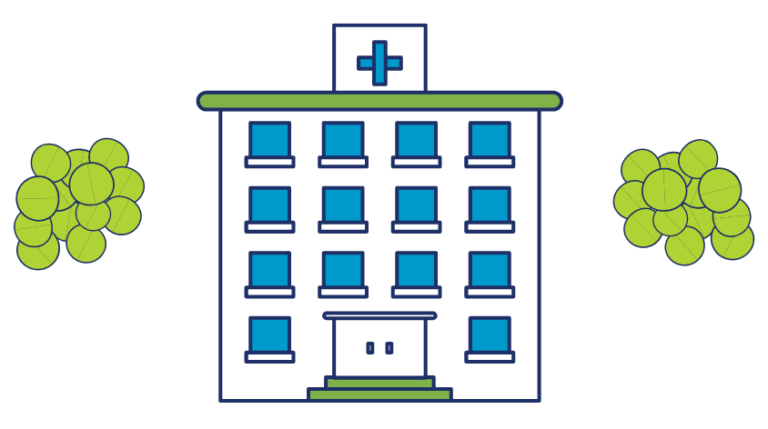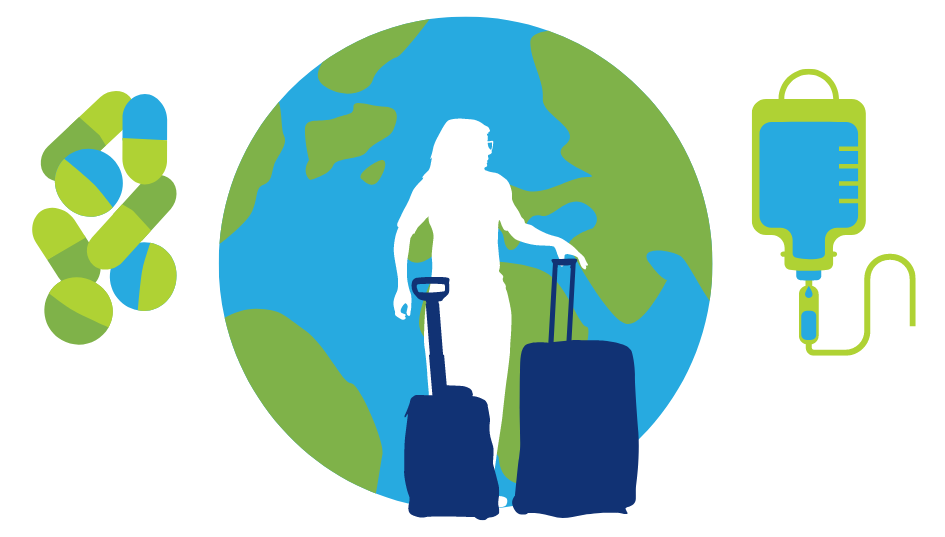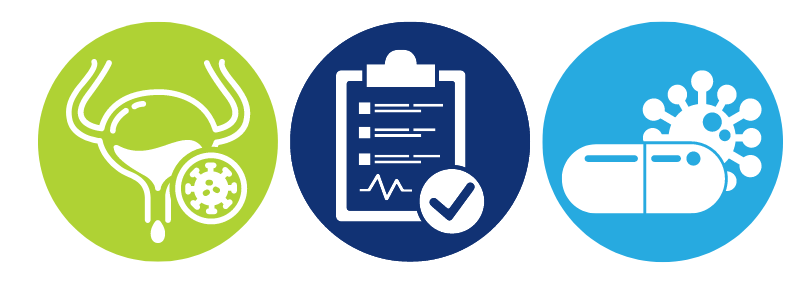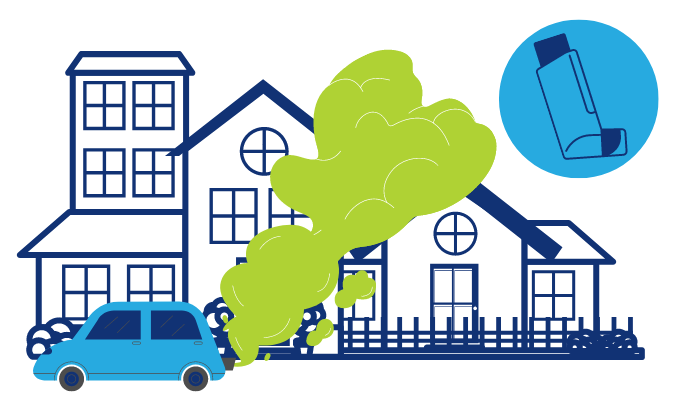
No one wants to be exposed to air pollution. No one wants to raise their kids breathing in polluted air in their own neighborhoods.
But in Austin, Texas, people of color are disproportionately forced to do both.
Dr. Sarah Chambliss, a research associate in the Department of Population Health at Dell Medical School at the University of Texas at Austin, led a team that ran a study of who is being affected by air pollution in Austin, neighborhood by neighborhood.
They found that while Austin has relatively little of the heavy industry traditionally linked with air pollution, it’s got plenty of polluted air. And the people living in the worst affected neighborhoods were far more likely to be Black or Latino(a) than White, they report in the American Journal of Respiratory and Critical Care Medicine.
It’s not just unpleasant. People living in polluted areas are much more likely to end up in emergency rooms for asthma attacks. That’s expensive for everyone because in the United States hospitals must treat people coming to emergency rooms in distress and those costs are passed along to taxpayers as well as to health insurers – who pass along those expenses to customers.
Aside from hurting people of color more than others, air pollution is costing everyone –in this case, residents of Austin– a lot of money, Chambliss tells One World, One Health host Maggie Fox. Listen as Chambliss explains what else she and her team found, and what can be done to address the problem.
Maggie Fox 00:01
Hello and welcome to One World, One Health where we take a look at some of the biggest problems facing our world. I’m Maggie Fox. This podcast is brought to you by the One Health Trust with bite-sized insights into ways to help address challenges, such as infectious diseases, climate change, and pollution. We take a One Health approach that recognizes that we’re all in this together and everything on this planet — the animals, plants, and people, and the climate and environment — are all linked.
Where you live matters! People have known about good neighborhoods, and bad neighborhoods since there were neighborhoods. We also now know that in the United States, zip codes are tied to health. You can predict health and even how long someone will live simply by looking at their postal delivery code.
What people still need to learn more about is — why? It’s painstaking work to break it down.But a team at the University of Texas in Austin has taken a close look at one important factor — air pollution. They found that several important types of air pollution are worse in areas with higher percentages of Black and Latino residents. Understanding this can give policymakers the information they need to make important decisions.
In this episode, we’re chatting with Sarah Chambliss, who led the study. She’s a research associate in the department of population health at the Dell Medical School at the University of Texas in Austin.
Sarah, thank you so much for joining us.
Sarah Chambliss 01:31
It’s my pleasure.
Maggie Fox 01:33
You’ve broken down people’s exposure to air pollution by neighborhood. What did you find?
Sarah Chambliss 01:39
Surprisingly, we found that within Austin, some neighborhoods are consistently more polluted over the year than other neighborhoods. We also found that depending on the kind of pollution that we were looking at — coarse particles, fine particles, or sulfur-based gas particles — some neighborhoods were higher in levels, some in sound levels than others. But in the neighborhood with residents who are either Black or Latinx, it was consistently a higher level of many of these types of pollution.
Maggie Fox 02:14
Why do you say you find this surprising?
Sarah Chambliss 02:17
Well, Austin is typically considered a city with clean air, unlike Houston which people think of as a big industrial center. I don’t think that we, in Austin, think about our air pollution being that bad.
In general, when people think about air quality, they’ll often think, “I live in a city, so it’s polluted,” or “I live in a rural area, so, it’s cleaner.” But people don’t necessarily think that if you drive two miles from one neighborhood to another, you’re driving from an area where health is much more strongly affected by the air than any other neighborhood.
Maggie Fox 02:52
Can you tell us a bit about this air pollution? If you say Austin is not an industrial city… and it is not, where’s this pollution coming from?
Sarah Chambliss 03:02
Sure, we do have a couple of power plants there (in Austin) — natural gas, (which is) not as dirty as coal-fired power plants. We have quite a bit of traffic that comes from I-35 (which is) in the middle of the city. I’d say traffic is a big contributor to our urban pollution. Then there are other distributed sources, some manufacturing in town, and landfills contribute to local pollution. So little things add up.
Maggie Fox 03:28
So, air doesn’t stay in just one place. So how does pollution in one area end up affecting another area? Or are these neighborhoods backed up by the sources?
Sarah Chambliss 03:40
Yeah, I’d say that neighborhoods that are right next to major freeways and major highways are getting the full blast of pollution from exhaust. As we get farther away from a highway, it gets more diluted. So, air mixes, yes! But right next to the sources, we’re getting the full run of the fumes.
Maggie Fox 04:01
Does the geography of Austin affect this in any way?
Sarah Chambliss 04:05
Well, there’s a lot of interesting dimensions to that. So, in the basic geography, there’s a flat area where most of the city started. Then if you go west, there’s Hill Country. The Hill Country tends to be more affluent, in addition to being less suitable for large industries to develop. Then the east side of Austin is a historically redlined area. Geography is influenced to a large degree by historically discriminatory housing practices. There are both historical and geographic levels to how neighborhoods have developed in Austin.
Maggie Fox 04:44
Redline, that’s a term some people understand, but can you explain that term a little bit?
Sarah Chambliss 04:50
This is a little bit beyond my own area of expertise, but it’s part of a larger issue where people of color were systematically denied housing loans and access to housing in (desirable) neighborhoods. Loans were given in neighborhoods where there were people of color.
There were also neighborhood covenants that were basically pushing segregation. So redlining is a little bit of a shortcut phrase for areas where segregation practices were most pronounced.
Maggie Fox 05:26
People were literally drawn out of certain neighborhoods, right?
Sarah Chambliss 05:30
Right! There were all kinds of systems in place that denied them the ability to live. Redlining coincided both with the places where people of color were allowed to live and the places where industry was allowed to develop.
Maggie Fox 05:45
That leads to my next question: Is anyone really surprised to find that people of color are more likely to live in these areas that are more affected? Our society and culture have pushed minorities into less desirable areas.
Sarah Chambliss 06:02
Well, “Is anyone surprised?”, is an interesting question. I think that there are people who just don’t think about it. There are probably people who would be surprised to hear this, even if they were more in touch with environmental justice news they wouldn’t be surprised (with).
I think one thing people are aware of is the concentration of pollution. Some of these neighborhoods are identified with several levels of social vulnerability that are higher. People are aware that in these high social vulnerability neighborhoods, there are higher concentrations of pollution.
But what the data very rarely shows yet, because people aren’t looking at it in this way, is that people are going to the hospital for asthma, for example, more in these neighborhoods. It’s like we know that the risks are higher, but collecting the data from health records and showing that these risks are borne out via health data requires an amount of statistical analysis (in order) to isolate that signal from a lot of other signals. I think that it is more novel and revealing that we see quantifiable, identifiable, higher health burdens associated with pollution levels.
Maggie Fox 07:19
Can we talk more about the health burden? People are showing up in the emergency room (ER). What’s happening there? 
Sarah Chambliss 07:24
We’ve looked at anybody who goes to the ER for asthma, and it includes children and adults with a background in Texas. The rates of asthma among Black children are much higher than among White children. Both Black and Latinx children with asthma tend to go to the ER at twice the rate of their White counterparts. So, it’s both that they develop asthma more and that the amount of asthma care they receive isn’t controlling it (the disease) as well.
Maggie Fox 08:00
Is that what it is? Is uncontrolled asthma a lack of access to healthcare?
Sarah Chambliss 08:06
You know, that’s a good point. This is one of the things we controlled for. We looked at the neighborhood’s uninsured rate alongside pollution and the share of households living under the poverty level. So, we also have some individual-level data that our lab has been looking at, which looks at the level of medication that a child is receiving when they receive their diagnosis. It’s a very inter-tangled issue — access to health care and being able to get a diagnosis and treatment. Those are things that contribute to higher rates of ER visits.
But we did our best to account for that. (We found that) simply being exposed to worse air pollution is something that can trigger asthma exacerbation that requires an emergency room visit. Even if the child has been diagnosed, it’s a known issue. (In our study) we’re talking about children and adults, and they (already) take medication, and higher air pollution can just be like one more straw that breaks the camel’s back, for some people.
Maggie Fox 09:10
It’s one more factor, all this stuff is piling up.
Sarah Chambliss 09:12
Yeah!
Maggie Fox 09:14
So how did you go about measuring this?
Sarah Chambliss 09:18
So, in the state of Texas, for the medical records, they collect information centrally from every hospital, and that’s it’s called the Texas Health Care Information Collection. You must do a bunch of administrative work to get access to it, because it’s private, protected data.We arranged to be able to use that data. And then there’s a lot of publicly available data on air pollution. We used one set from the Center for Air, Climate, and Energy Solutions. Right now, we’re comparing the results from those sets of pollutants with another set of pollutants.
So, Publicly available air pollution data, and then somewhat of a pain to get access to — healthcare data.
Maggie Fox 10:02
So how can you use your findings? Will you advocate for change? Can someone else take your findings and use them to advocate for change?
Sarah Chambliss 10:10
Well, you know, I don’t make policies. Sometimes I talk to policymakers, I think that different audiences respond differently to different kinds of information. They are at the legislative level, there are hard calculations that go on where they say, “Well, it’s going to cost this amount of money to control air pollution. It is going to hurt the economy. So how can we justify that economic hit?”
When you say, “We’ll think about how much it costs for missed workdays, for healthcare, for emergency healthcare for an asthmatic exacerbation, and for the medication required, in addition to emotional toll of how difficult it is to deal with your child not being able to breathe” You’re also able to put these financial numbers — to air pollution costing Texas a lot of money, because of the health impacts that it’s having. It’s like the cold way of calculating or thinking about it.
I think it also helps people in these neighborhoods feel more urgency in advocating for clean air, letting them know that when they support efforts and opportunities to get a big polluter out of their neighborhood, they’re going to see health benefits for themselves, their families, and neighbors.
Maggie Fox 11:27
It really can be a pragmatic calculation, because it costs a lot more to show up at the ER than it does to just prevent a problem in the first place.
Sarah Chambliss 11:38
Yeah, like I said, I’m not a policymaker, and not involved in sitting down and writing out these calculations. But I think that oftentimes, the way that change happens in reducing air pollution is by putting up all these healthcare costs against the cost of controlling air pollution. Realizing that releasing something into the air, even though it’s convenient and helps you get your product made, is having such a detrimental effect on society, that you are costing people a lot by doing it.
Maggie Fox 12:09
You found these great disparities in a city like Austin, which you say does not have a lot of industry, where you don’t have a lot of heavy-duty industry in neighborhoods. It’s a place where there is good healthcare available. What might be going on in places that are a little less open to this kind of intervention?
Sarah Chambliss 12:32
Yeah, that is an excellent point that the amount of local interest in preventing the overdevelopment of highly polluting industries is much higher within Austin City Limits than in many other communities. I think this is a neglected area of inquiry, that being in a place that doesn’t have local limits, you’re at the mercy of what the state lawmakers want to make. And if they’re not aware of how bad things are in their neighborhood, they don’t have a reason to say, “Oh, yeah, this factory that’s gonna bring in millions of dollars to the state economy is not worth it.”
People who live in those neighborhoods don’t have a place to complain or advocate that these sources should not be there. If the sources are already there, they’re ratcheting up. That’s another thing that happens — a source will be placed somewhere with a certain level that they agree; this is how much this is the limit of the pollution here. Then they’ll keep applying to be able to pollute more and more.
I think that this is adjacent to what I do. But it’s something that we see, as we’re looking at this problem from a healthcare perspective than from a public health perspective. One interesting thing we’re looking forward to is that the United States Environmental Protection Agency (US EPA) has put in place this stricter limit on particulate matter 2.5 (PM 2.5) — tiny particles or droplets in the air that are 2 ½ microns or less in width.
That’s taken it down from 12 micrograms per cubic meter to 9, which puts certain neighborhoods in Austin in non-compliance. It puts a lot of areas in a lot of cities that had been considered clean.
Now, it’s forcing local and state actors to make plans to reduce pollution. One thing that isn’t usually supported by Clean Air Act-type policies is saying we’re gonna go into neighborhoods with a higher burden of socio-demographic factors that lead to worse access to healthcare and think of opportunities to improve pollution in those neighborhoods.
Maggie Fox 14:28
So, what you’re saying is federal policy can make a difference. These new environmental protection agency guidelines or rules can have a local effect.
Sarah Chambliss 14:38
Right! There needs to be some motivation to act. When you’re balancing economic growth against public health and you don’t have some sort of mandate to protect public health, it doesn’t end up being the priority.
Maggie Fox 14:52
Sarah, thank you so much for joining us and explaining all this to us.
Sarah Chambliss 14:56
Yeah, absolutely. I’m glad to have the conversation.
Maggie Fox 15:00
Listeners. If you enjoyed this podcast, please share it. You can learn more about this podcast and other important topics at onehealthtrust.org and let us know what else you’d like to hear about at
[email protected]. Thanks for joining us.
Guest
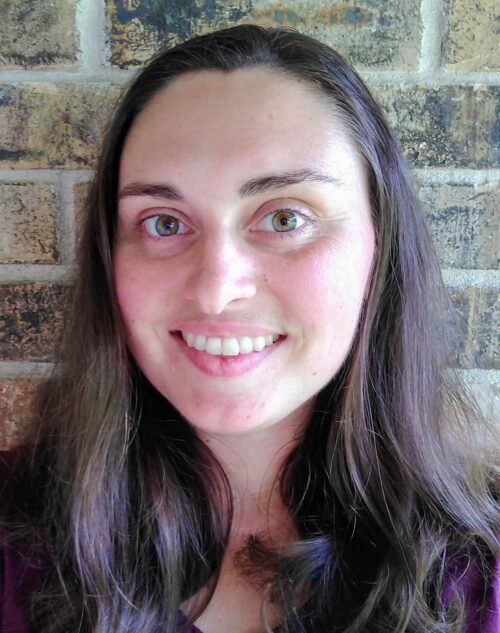
Dr. Sarah Chambliss, Ph.D., MSE is a Research Associate in the Department of Population Health at the University of Texas at Austin Dell Medical School. She earned her Master of Science in Engineering and Ph.D in Civil Engineering from the department of Civil, Architectural, and Environmental Engineering at the Cockrell School of Engineering at UT Austin, specializing in urban air quality with a focus on the drivers of neighborhood-scale pollution gradients and their implications for exposure and environmental justice. Dr. Chambliss currently focuses on identifying the impact of localized air pollution exposure inequity on within-city racial and ethnic disparity in asthma.
Credits
Hosted and written by Maggie Fox
Special guest: Sarah Chambliss
Produced and edited by Samantha Serrano
Music composed and sound edited by Raquel Krügel
Transcript edited by Namitha Prabhu




